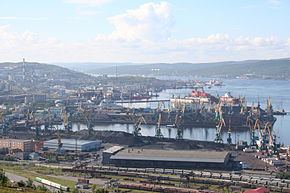 | ||
Murmansk Commercial Seaport (Russian: Мурманский морской торговый порт) is a seaport located on the eastern shore of the Kola Bay of the Barents Sea in the city of Murmansk. The port ranks fourth in Russia in terms of processed goods and the second largest in the north-west of Russia (after the port of St. Petersburg). Murmansk seaport is one of the largest ice-free ports in Russia is the backbone of the economy of the city. The port is managed and operated by JSC Murmansk Commercial Port. April 22, 2013 the company acquired 47.67% EuroChem shares Murmansk Commercial Sea Port. Seaport has 13 berths and is equipped with the modern handling facilities: 52 gantry cranes with the capacity up to 40 tn, 1 shiploader for handling of apatite concentrate with the capacity more than 1000 th tn/hour, 113 units of fork trucks with the capacity from 1.5 to 32 ton. On April 2013, 49.86% of the shares are owned by SUEK. Both companies are controlled by Russian businessman Andrey Melnichenko.
Contents
History
By the beginning of World War I, the only two Russian ports in the northwest were Arkhangelsk and St. Petersburg (later renamed Petrograd). However, after the blocking of the Ottoman Empire's straits of the Bosphorus and Dardanelles to outside shipping and blockading of the Baltic Sea port of St. Petersburg, the Russian Empire could only use the northern port of Arkhangelsk. This port had limitations: when winter presented itself, navigation and shipping of any sort came to a halt. Therefore, it was decided to build a new port. The chosen location was in Murmansk due to its ability to accommodate sea traffic year-round, proximity to existing communities and relative easeto connect it to the empire's expanding railway network.
The first planned work began in early July of 1915 and, on September 1 of the same year the steamer "Drott" with a cargo from New York was able to moor to a temporary jetty port. The first train to the port arrived approximately one year after the railway was built to Kandalaksha.
Soviet period
After September 1, 1939 through the port of Murmansk started delivering cargo to Spain. During the Great Patriotic War took place in the port of unloading convoys of allied countries.
In 1966, the Murmansk seaport was awarded the Order of the Red Banner.
Modern period
In 1994, state-owned enterprise was established Joint Stock Company "Murmansk Commercial Seaport".
Murmansk port is homeport barque "Sedov", the largest sailing ship in the world. Also attributed to the port all Russian nuclear-powered icebreakers . In May 2007 it was decided to set up in Murmansk port free trade zone . On 15 October 2010 Murmansk was officially declared a special economic zone. The main goal - to create a powerful transport and trade infrastructure, attracting investment and ultimately social development.
Murmansk port consists of three parts: Fishing port, commercial port and passengers port. In recent years, the trend of repression of all other trading ports because of the increase in exports of coal and a number of other mineral resources, for the reception and storage of Murmansk which has the necessary infrastructure. Significantly reduced intake of fish, as it became more profitable to export, rather than inside the country.
In the autumn of 2010, the Association of Commercial Seaports recognized Murmansk commercial port best Russian company that owns the moorings and performs stevedoring work.
In February 2011, it was reported that the structure of Gennady Timchenko, one of the owners of the company Gunvor, buy Murmansk Commercial Seaport for $250 million, but later it was disproof representative Timchenko.
Since 2011 is the development of an investment project "Integrated Development of the Murmansk transport hub". And from 2013 to 2020 is planned for the construction of the Murmansk transport hub, allowing Murmansk will be the main base of the Northern Sea Route and the base for the exploration of the Arctic.
By the end of 2012 cargo turnover increased by 8.6% to 15.69 million tons and is the second largest cargo port in the north-western part of Russia after the port of St. Petersburg.
